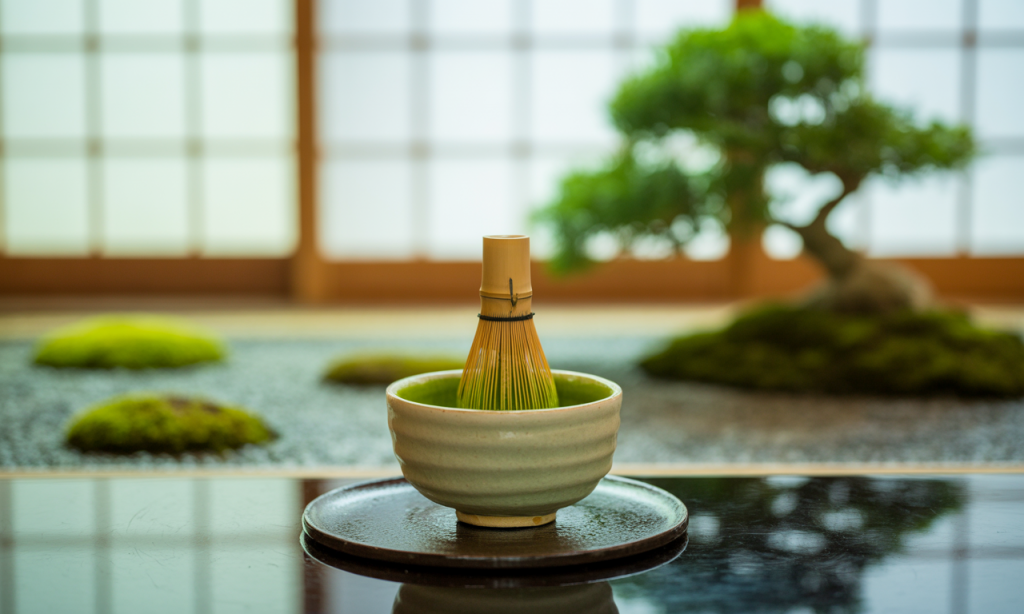
Matcha Superfood: From Daily Ritual to Nutritional Powerhouse
Discover how matcha, the vibrant green powdered tea from Japan, transformed my morning routine and provided a comprehensive solution to my superfood quest. This document explores matcha's exceptional nutritional profile, health benefits, and practical applications - offering insights on how this ancient beverage can revolutionise your wellness routine while potentially saving you time and money compared to complex superfood regimens.
==> 🌈💟⭐💗 CLICK HERE TO GET YOUR "Matcha Superfood" FROM THE Authority Site" 🌈💟⭐💗 ==>
My Morning Routine: The Start of a Superfood Quest
For years, my wellness journey involved frequent pilgrimages to Whole Foods, occurring like clockwork every two weeks. These weren't casual shopping trips - they were missions to acquire an arsenal of superfoods and nutritional supplements that had become essential to my morning ritual.
The financial investment was substantial. Each trip resulted in a shopping basket filled with individual superfoods - spirulina, chlorella, various berries, seeds, and powders - all commanding premium prices. Despite the cost, I remained committed to this routine, believing it necessary for optimal health.

What began as a health-conscious decision gradually evolved into a complex and expensive habit. I found myself seeking a more streamlined solution - something that could provide comparable nutritional benefits without the complexity and cost of my current regimen.
==> 🌈💟⭐💗 CLICK HERE TO GET YOUR "Matcha Superfood" FROM THE Authority Site" 🌈💟⭐💗 ==>
What Is Matcha? Origins and Unique Production
Shade-Grown Cultivation
Unlike conventional teas, matcha begins with specially cultivated Tencha leaves. Farmers shade the plants for weeks before harvest, triggering increased chlorophyll and amino acid production. This meticulous process creates the foundation for matcha's exceptional nutritional profile.
Selective Harvesting
Only the youngest, most tender leaves are carefully handpicked during harvest. These premium leaves contain the highest concentration of beneficial compounds and contribute to the tea's smooth, refined flavour profile.
Traditional Stone-Milling
The dried leaves are meticulously ground using granite stone mills, moving slowly to prevent heat damage to delicate nutrients. This produces the ultra-fine powder that dissolves completely in water, allowing you to consume the entire leaf rather than merely an infusion.
This traditional Japanese preparation method has remained largely unchanged for centuries, preserving matcha's status as a complete nutritional powerhouse. When you drink matcha, you're consuming the whole leaf and all its nutrients - a fundamental difference from other teas.
==> 🌈💟⭐💗 CLICK HERE TO GET YOUR "Matcha Superfood" FROM THE Authority Site" 🌈💟⭐💗 ==>
Matcha Superfood→ Click Here – “OFFICIAL WEBSITE”
Matcha vs. Other Green Teas
The nutritional superiority of matcha compared to conventional green teas stems primarily from its unique preparation method. While standard teas involve steeping leaves and discarding them, matcha consumption involves ingesting the entire leaf in powdered form.
This fundamental difference creates a dramatic nutritional disparity. Research suggests matcha contains up to 137 times more antioxidants than low-grade green tea and significantly more than even high-quality sencha or black teas.
The whole-leaf consumption also means matcha delivers higher levels of vitamins, minerals, amino acids, and dietary fibre. This nutritional density makes matcha a more complete food source than conventional teas, which primarily offer water-soluble compounds.
Antioxidant Power: Catechins and EGCG
Powerful Catechin Content
Matcha contains approximately 10g of catechins per 100g of powder, with epigallocatechin gallate (EGCG) being the most abundant and studied. These potent polyphenol antioxidants are what give matcha its reputation as a superfood.
Disease-Fighting Properties
EGCG has been extensively researched for its potential anti-cancer and anti-inflammatory effects. Studies suggest it may help inhibit tumour growth, reduce inflammation, and protect against various chronic diseases.
Cellular Protection
The antioxidants in matcha help neutralise harmful free radicals that damage cells and accelerate ageing. This protective effect may contribute to matcha's association with longevity and reduced disease risk.
Dietary Fibre Content
One of matcha's most overlooked nutritional benefits is its impressive dietary fibre content - approximately 38.5g per 100g of powder. This makes matcha exceptionally rare among beverages, as most drinks contain negligible fibre.
The soluble and insoluble fibre in matcha provides multiple health benefits, including improved digestive regularity, stabilised blood sugar levels, and enhanced satiety. These properties make matcha particularly valuable for those managing weight or blood glucose concerns.
Daily Fibre Intake
A typical serving of matcha (2g) provides approximately 0.77g of fibre, contributing significantly to your daily requirements compared to other beverages.
Gut Health Support
The fibre in matcha acts as a prebiotic, nourishing beneficial gut bacteria and supporting overall digestive wellness.
For those seeking to increase dietary fibre intake, incorporating matcha into daily routines offers a convenient method that simultaneously delivers numerous other nutritional benefits.
Essential Vitamins in Matcha
Vitamin A (Beta-Carotene)
Matcha contains significant amounts of beta-carotene, which the body converts to vitamin A. This essential nutrient supports healthy vision, skin integrity, and immune function. The vibrant green colour of matcha partly reflects its rich beta-carotene content.
Vitamin C
Though less known for vitamin C than citrus fruits, matcha provides a meaningful amount of this essential nutrient. Vitamin C supports immune function, collagen synthesis for healthy skin, and acts as an antioxidant protecting cells from damage.
Vitamin E
As a fat-soluble antioxidant, the vitamin E in matcha helps protect cell membranes from oxidative damage. It works synergistically with other antioxidants in matcha to provide comprehensive cellular protection and support overall health.
Vitamin K
Matcha is an excellent source of vitamin K, which plays crucial roles in blood clotting, bone metabolism, and heart health. The bioavailability of vitamin K in matcha is enhanced by its powdered form and whole-leaf consumption.
Matcha Superfood→ Click Here – “OFFICIAL WEBSITE”
Key Minerals for Vitality
| Mineral | Content in Matcha | Primary Benefits |
| Calcium | Medium | Bone strength, nerve transmission, muscle function |
| Potassium | High | Blood pressure regulation, fluid balance, muscle contractions |
| Magnesium | Medium-High | Energy production, nervous system support, muscle relaxation |
| Iron | Moderate | Oxygen transport, cognitive function, immune support |
| Phosphorus | Moderate | Bone formation, energy metabolism, cell membrane structure |
The mineral profile of matcha offers comprehensive support for multiple body systems. Unlike supplements that provide isolated nutrients, matcha delivers these minerals in natural balance with cofactors that enhance absorption and utilisation. This synergistic effect is difficult to replicate with synthetic supplements.
Caffeine and L-Theanine: The Balanced Energy
Matcha contains approximately 3.2g of caffeine per 100g of powder, translating to roughly 30-70mg per serving—less than coffee but more than most green teas. However, the caffeine experience with matcha is fundamentally different from other caffeinated beverages.
The secret lies in matcha's unique combination of caffeine with L-theanine, an amino acid that promotes relaxation without drowsiness. This natural pairing creates what many describe as "calm alertness"—sustained energy without the jitters, anxiety, or crash often associated with coffee consumption.
Chlorophyll and Natural Detoxification
The striking emerald hue of high-quality matcha reveals its exceptional chlorophyll content—a direct result of the shade-growing process that forces the tea plants to increase chlorophyll production to compensate for reduced sunlight.
Natural Detoxification Support
Chlorophyll has been studied for its ability to bind with and remove various environmental toxins from the body, potentially supporting the liver's natural detoxification processes. Regular matcha consumption may help eliminate heavy metals, chemical pollutants, and other harmful compounds.
Blood-Building Properties
The molecular structure of chlorophyll closely resembles human haemoglobin, leading some researchers to suggest it may support red blood cell production and improve oxygen transport throughout the body. This could contribute to improved energy levels and athletic performance.
Alkalising Influence
Chlorophyll-rich foods like matcha are believed to have an alkalising effect on the body, potentially helping to counterbalance the acidic conditions created by many modern dietary staples. This may support overall health and reduce inflammation.
==> 🌈💟⭐💗 CLICK HERE TO GET YOUR "Matcha Superfood" FROM THE Authority Site" 🌈💟⭐💗 ==>
How Matcha May Boost Metabolism and Fat Loss
Research suggests matcha may offer significant benefits for metabolism and weight management through multiple mechanisms. The combination of catechins (particularly EGCG) and caffeine appears to create synergistic effects that exceed what either compound provides independently.
In one 12-week study, participants consuming green tea extract containing catechins and caffeine experienced significantly greater fat oxidation and energy expenditure compared to a control group. The thermogenic effect—increased calorie burning—was measurable for up to 24 hours after consumption.
Thermogenesis
Matcha's combination of catechins and caffeine stimulates the body to produce more heat, burning additional calories even at rest.
Fat Oxidation
EGCG appears to enhance the body's ability to use stored fat as energy during exercise and daily activities.
Muscle Preservation
Unlike some stimulants, matcha's compounds appear to target fat while helping preserve lean muscle mass.
Focus, Mood, and Cognitive Benefits
The cognitive benefits of matcha represent one of its most immediately noticeable effects. The unique combination of L-theanine and caffeine creates a neurological environment conducive to both focus and calm—a state many users describe as "mindful alertness."
L-theanine in Matcha
Per 100g of powder, promotes alpha brain wave production associated with relaxed attention and creativity.
Duration of Effects
The cognitive benefits typically last significantly longer than coffee due to the time-release effect of L-theanine.
Improved Accuracy
Research shows tasks requiring attention experienced significant accuracy improvements after matcha consumption.
Many regular matcha drinkers report improved ability to maintain focus on complex tasks without the anxiety or jitteriness often experienced with other caffeinated beverages. This may be particularly beneficial for creative professionals, students, and anyone engaged in cognitively demanding work.
Studies on Disease Prevention
The potential health-protective effects of matcha extend far beyond daily energy and focus benefits. Numerous scientific studies have investigated the role of matcha's compounds—particularly EGCG and other catechins—in preventing and potentially treating various diseases.
Cancer research has shown particularly promising results. In laboratory studies, EGCG has demonstrated the ability to induce apoptosis (programmed cell death) in cancer cells while leaving healthy cells unharmed. Population studies in regions with high green tea consumption show correlations with reduced cancer incidence, though more research is needed to establish direct causality.
Cancer Protection
Studies suggest EGCG may help prevent cancer initiation, promotion, and progression through multiple mechanisms including antioxidant activity and cell signaling modification.
Cardiovascular Health
Research indicates regular matcha consumption may improve lipid profiles, reduce blood pressure, and protect against atherosclerosis through anti-inflammatory and antioxidant pathways.
Neurodegenerative Disease
Emerging evidence suggests compounds in matcha may protect neural cells and potentially slow progression of conditions like Alzheimer's and Parkinson's disease.
The Japanese Matcha Advantage: Quality Matters
Not all matcha is created equal. The nutritional profile and experiential benefits vary dramatically based on production methods, growing conditions, and processing techniques. Japanese matcha, particularly from regions like Uji and Nishio, typically offers superior quality due to centuries-refined cultivation practices.
Ceremonial Grade
The highest quality, made from first-harvest leaves with stems and veins removed, stone-ground to the finest texture. Vibrant green with sweet, umami flavour.
Premium Grade
High-quality first or second harvest leaves with good nutritional profile. Bright green with pleasant taste, suitable for daily drinking.
Culinary Grade
Later-harvest leaves with stronger, more bitter taste. Less vibrant colour but still nutritious. Best used in cooking, baking, and smoothies.
Commercial Grade
Often non-Japanese, may contain stems and lower-quality leaves. Duller green with astringent taste. Significantly lower nutritional content.
The nutritional advantages of premium Japanese matcha justify the higher price point for those seeking maximum health benefits. The careful shade-growing, selective harvesting, and traditional processing preserve delicate compounds that may be degraded in lower-quality products.
Matcha Superfood→ Click Here – “OFFICIAL WEBSITE”
Ritual and Mindfulness: More Than Nutrition
Beyond its impressive nutritional profile, matcha offers something increasingly rare in our fast-paced world: an invitation to mindfulness. Traditional Japanese tea ceremonies (chanoyu) have centred around matcha preparation for centuries, emphasising presence, attention to detail, and appreciation of the moment.
Even simplified daily matcha preparation can serve as a meaningful ritual—a brief pause in the day's demands to focus on a single, intentional activity. This ritual aspect creates a powerful mind-body connection that enhances the overall experience and potentially amplifies the physiological benefits.

Many matcha enthusiasts report that this mindful preparation and consumption practice helps reduce stress and anxiety independently of the tea's chemical constituents. The act of preparing and consuming matcha becomes a form of moving meditation—an opportunity to cultivate mindfulness that extends beyond the teacup.
Cost Comparison: Matcha Versus Superfood Blends
When evaluating matcha's cost-effectiveness compared to other superfood options, it's important to consider both direct costs and convenience factors. High-quality ceremonial matcha typically costs £25-45 for a 30g tin, which provides approximately 30 servings—roughly £1-1.50 per day.
Compared to purchasing multiple individual superfoods (spirulina, chlorella, wheatgrass, maca, etc.) or premium blended products, matcha often represents significant savings. The comprehensive nutritional profile of matcha can potentially replace several separate supplements, simplifying both purchasing and daily preparation routines.
Beyond monetary savings, the time and mental energy saved from simplified shopping and preparation creates additional value that shouldn't be overlooked. Many find that replacing a complex superfood regimen with daily matcha improves consistency and sustainability of their health practices.
==> 🌈💟⭐💗 CLICK HERE TO GET YOUR "Matcha Superfood" FROM THE Authority Site" 🌈💟⭐💗 ==>
Practical Ways to Use Matcha Daily
Traditional Matcha Tea
The purest preparation: sift 1-2g matcha into a warm bowl, add 60ml water (80°C), and whisk vigorously in an "M" motion until frothy. Drink immediately for maximum antioxidant benefits and L-theanine effects.
Matcha Smoothies
Add 1/2-1 teaspoon to your morning smoothie for a nutritional and energy boost. Pairs excellently with banana, avocado, spinach, and plant-based milks. The fat content helps absorption of fat-soluble nutrients.
Culinary Applications
Incorporate matcha into baked goods, overnight oats, energy balls, or even savoury dishes. Culinary grade matcha works best for cooking, as its stronger flavour holds up to other ingredients.
For optimal matcha storage, keep your powder in an airtight container away from light, heat, moisture, and strong odours. Refrigeration can extend freshness but be sure to allow the container to reach room temperature before opening to prevent moisture condensation on the powder.
==> 🌈💟⭐💗 CLICK HERE TO GET YOUR "Matcha Superfood" FROM THE Authority Site" 🌈💟⭐💗 ==>
How Much Matcha is Enough? Safety and Dosage
While matcha offers numerous health benefits, determining appropriate consumption levels requires balancing potential advantages with caffeine sensitivity and practical considerations. Most experts recommend 1-2 servings daily for optimal benefits.
A typical matcha serving contains approximately 1-2 grams of powder, providing roughly 30-70mg of caffeine—less than a cup of coffee but more than most teas. For those sensitive to caffeine, starting with half a serving and consuming matcha earlier in the day can help prevent sleep disruption.
Daily Intake
1-2 servings (1-2g each) is considered optimal for most adults seeking health benefits without excessive caffeine.
Timing
Morning or early afternoon consumption maximises energy benefits while minimising potential sleep disruption.
Cautions
Pregnant women, those with severe caffeine sensitivity, or individuals on certain medications should consult healthcare providers.
The beneficial compounds in matcha appear to have excellent safety profiles at typical consumption levels. Research suggests the catechin content would need to exceed approximately 800mg daily (equivalent to 8+ servings) before concerns about liver effects might arise in sensitive individuals.
Addressing Common Misconceptions
All Green Tea Powder is Matcha
False. Genuine matcha comes specifically from shade-grown tencha leaves that undergo proper processing and stone-grinding. Many products labeled as "matcha" internationally are actually powdered sencha or other green teas, which have significantly different nutrient profiles and taste characteristics.
The Bitterness Indicates Quality
False. High-quality matcha should have a balanced, slightly sweet taste with umami notes and minimal bitterness. Excessive bitterness often indicates lower quality, older leaves, or improper processing. The vibrant green color comes from proper shade-growing and handling, not additives.
Culinary Grade is Nutritionally Inferior
Partially true. While culinary-grade matcha generally contains fewer antioxidants than ceremonial grades, it still offers significant nutritional benefits compared to other beverages. For cooking applications, the stronger flavor profile of culinary grades actually works in your favor.
All Matcha Contains Lead
Misleading. Tea plants can absorb lead from soil, but proper sourcing from tested fields and reputable producers minimizes this risk. Japanese matcha typically undergoes rigorous testing, with ceremonial grades adhering to particularly strict standards for heavy metals and contaminants.
Conclusion: The Superfood That Sticks
My journey from an expensive, complex superfood routine to daily matcha consumption represents more than just a simplification—it's been a revelation about sustainability in wellness practices. What makes matcha remarkable isn't just its impressive nutritional profile, but how effortlessly it integrates into daily life.
The comprehensive benefits of matcha—from antioxidant protection and balanced energy to cognitive enhancement and potential disease prevention—create a compelling case for making it a cornerstone of any health regimen. Unlike many trending superfoods that fade from our routines, matcha offers a perfect balance of convenience, efficacy, tradition, and enjoyment.

Perhaps most importantly, matcha demonstrates that nutritional density and ritual pleasure can coexist—that taking care of our health doesn't require sacrificing enjoyment or spending a fortune. By embracing this centuries-old superfood, we connect with both timeless wisdom and cutting-edge nutritional science.
For those seeking to streamline their wellness routines without compromise, matcha offers a singular solution that has certainly transformed my approach to daily nutrition.
Read More Matcha Superfood
Matcha Superfood Read More This Website
https://www.ecombuzzer.com/product/matcha-superfood/
https://www.wownewswire.com/product/matcha-superfood/
https://viralpressnews.com/news-release/matcha-superfood/
https://colab.research.google.com/drive/1jjrRVLC78Cz5YDVAJUteyF5CVBnojqvk#scrollTo=XtQZILkviV8F
https://www.facebook.com/groups/matchasuperfood
https://issuetracker.google.com/issues/427502265
https://sites.google.com/view/matcha-superfood-website/home
https://groups.google.com/g/matcha-superfood-website
https://medium.com/@drherrymorking/matcha-superfood-drink-the-ultimate-morning-boost-9ac84b72c50d
https://www.instagram.com/matchasuperfoodwebsite/
TAG
#MatchaSuperfood
#health
#offering
#routine
#morning
#beneficial
